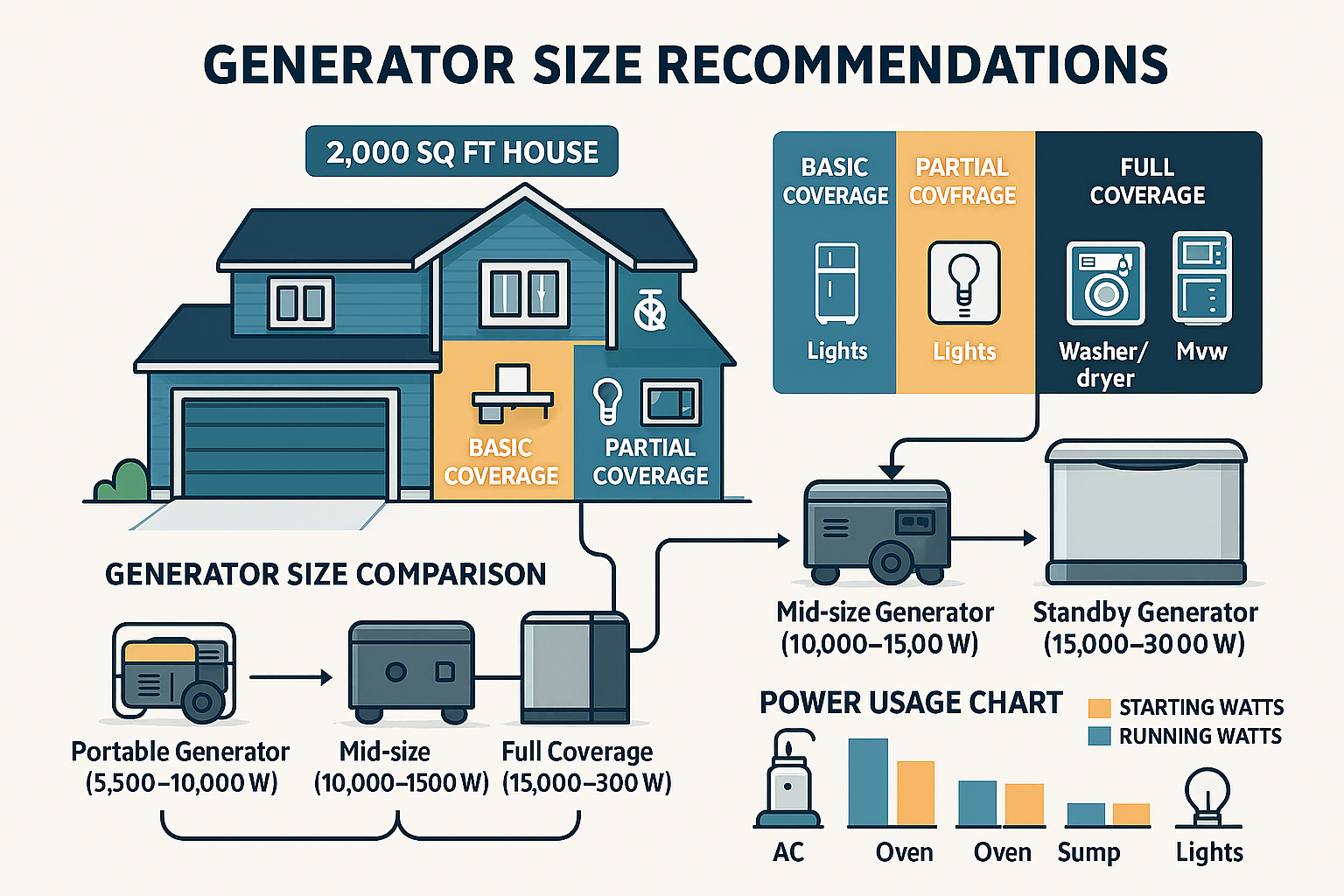What Size Generator Do I Need to Run a 2,000 Sq Ft House?
Power outages can cause more than just a temporary inconvenience—they can leave your home without heating or cooling, spoil your food, and even cause damage to appliances or electronics.
For a 2,000 square foot house, selecting the correct generator size is essential to keep critical systems running and maintain comfort and safety.
However, buying a generator isn’t about choosing the biggest or most expensive model. It’s about calculating your household’s energy requirements and matching them with a generator that can handle both the continuous (running) and startup (surge) wattage of your appliances and systems.
Understanding Generator Sizes
Generator sizes are rated in watts (W) or kilowatts (kW), where 1 kW equals 1,000 watts. The size you need depends on the total load (in watts) of the devices and systems you want to power, particularly those that draw more power during startup.
For a home of 2,000 square feet, the recommended generator size generally falls between 15 kW and 30 kW, depending on how much of the house you want to power during an outage.
Basic Coverage vs. Full Coverage
The amount of power you need depends on whether you’re looking for basic, partial, or full home backup.
Basic Coverage
This setup powers only the most essential systems, such as:
- Refrigerator
- Lighting
- Sump pump
- A few outlets
- Possibly a space heater or window AC
For this level, a generator in the range of 5,500 to 10,000 watts is typically sufficient.
Partial Coverage
Partial backup adds convenience and comfort by covering:
- Central air conditioning
- Electric water heater
- Microwave
- Washer and dryer (if electric)
- Some electronics
A generator between 10,000 and 15,000 watts is usually suitable.
Full Coverage
If you want to power the entire home, including:
- HVAC system
- Kitchen appliances
- Water heater
- Washer and dryer
- All lights and outlets
Then you’ll need a generator rated between 15,000 and 30,000 watts (15–30 kW). The higher end of this range is especially recommended for all-electric homes or those with high-energy-demand appliances.
Key Factors That Influence Generator Size
Several factors can increase or decrease your power requirements:
HVAC Load
Central air conditioners and electric heating systems are often the largest energy consumers. A typical 3-ton AC unit can draw up to 3,500–5,000 starting watts. If your home has multiple systems or a heat pump, that load increases.
Appliance Type
Electric ovens, stoves, water heaters, and dryers require more power than their gas-powered counterparts. Homes with mostly electric appliances will need a more powerful generator.
Energy Efficiency
Newer, well-insulated homes with LED lighting and Energy Star appliances may require significantly less power than older, inefficient homes.
Simultaneous Use
Running multiple heavy appliances at once, such as an AC unit and an electric dryer, requires a generator that can handle the combined starting and running loads.
Recommended Generator Sizes for a 2,000 Sq Ft House
Here’s a guideline based on power demand levels:
- 5,500 – 10,000 watts: Suitable for basic needs like lighting, a fridge, and small appliances.
- 10,000 – 15,000 watts: Good for partial home coverage including HVAC and water heating.
- 15,000 – 24,000 watts: Ideal for full home coverage in gas-powered homes.
- 24,000 – 30,000+ watts: Best for all-electric homes or where complete power independence is desired.
Appliance Power Consumption Chart
Here are typical power requirements for common household appliances:
| Appliance | Running Watts | Starting Watts |
|---|---|---|
| Refrigerator | 700 | 2,200 |
| Freezer | 700 | 2,200 |
| Central Air Conditioning (3-ton) | 3,500 | 5,000 |
| Electric Water Heater | 4,500 | 4,500 |
| Electric Furnace (blower) | 1,200 | 2,000 |
| Microwave | 1,000 | 1,000 |
| Dishwasher | 1,200 | 2,400 |
| Washing Machine | 1,200 | 3,600 |
| Electric Dryer | 3,000 | 6,000 |
| Lights (total average home) | 500–1,000 | 500–1,000 |
| Sump Pump | 800 | 2,000 |
| Coffee Maker | 1,000 | 1,000 |
| Toaster | 1,200 | 1,200 |
Note: Starting (surge) watts can be two to three times the running watts, especially for appliances with motors.
Portable vs. Standby Generators
When choosing a generator, you’ll also need to decide between a portable and a standby model.
Portable Generators
- Power Range: 2,000 to 10,000 watts
- Fuel: Gasoline, diesel, or propane
- Pros: Lower cost, mobility, temporary use
- Cons: Manual startup, limited capacity, shorter runtime
- Ideal For: Basic or partial backup
Standby Generators
- Power Range: 7 kW to 36 kW
- Fuel: Natural gas or propane
- Pros: Automatic operation, powers entire home, long lifespan
- Cons: Higher cost, professional installation required
- Ideal For: Full-home or long-term backup
How to Calculate Your Generator Size Needs
To determine the right generator size:
- List the Appliances You Want to Run: Start with essentials, then add comfort appliances.
- Add Up the Running Watts: This shows your continuous load.
- Identify the Appliance with the Highest Starting Watts: Add this to the total running watts to estimate peak load.
- Select a Generator with Adequate Capacity: Include a buffer for unexpected loads or future needs.
Example
Suppose you want to power:
- Refrigerator (2,200W starting)
- Freezer (2,200W starting)
- Central AC (5,000W starting)
- Water heater (4,500W)
- Lights (1,000W running)
- Microwave (1,000W starting)
Total starting watts: 14,900
Total running watts: 10,400
You’d need a generator rated for at least 15,000 watts to cover these appliances safely.
Fuel Type Considerations
The type of fuel affects generator performance, cost, and availability.
Gasoline
- Pros: Easy to obtain
- Cons: Short shelf life, flammable, requires frequent refueling
Propane
- Pros: Clean-burning, long shelf life
- Cons: Requires large storage tanks
Natural Gas
- Pros: Unlimited supply if connected to utility line, low maintenance
- Cons: Not available everywhere
Diesel
- Pros: Fuel-efficient, durable engines
- Cons: Louder, heavier, more maintenance required
Installation and Safety Tips
- Hire a Licensed Electrician: Especially for standby generators and transfer switches.
- Use a Transfer Switch: Prevents dangerous backfeeding into the grid.
- Proper Placement: Keep at least 5 feet away from windows and doors.
- Never Operate Indoors: Generators emit carbon monoxide, which is deadly in enclosed spaces.
- Regular Maintenance: Run the generator monthly, change oil as needed, and check fuel quality.
Here’s a product recommendation table with Amazon links for popular generators suitable for powering a 2,000 sq ft house. The list includes both portable and standby generators, sorted by power output and typical use case:
| Generator Model | Type | Wattage | Fuel Type | Features | Amazon Link |
|---|---|---|---|---|---|
| Westinghouse WGen9500DF | Portable | 9,500 running / 12,500 peak | Dual Fuel (Gas/Propane) | Electric start, remote key fob, transfer switch ready | View on Amazon |
| Champion 100111 | Portable | 12,000 running / 15,000 peak | Gasoline | Electric start, IntelliGauge, rugged wheels | View on Amazon |
| DuroMax XP13000HX | Portable | 10,500 running / 13,000 peak | Dual Fuel (Gas/Propane) | CO Alert, MX2 Power Boost, all-metal construction | View on Amazon |
| Generac GP15000E | Portable | 15,000 running / 22,500 peak | Gasoline | Electric start, large fuel tank, low oil shutdown | View on Amazon |
| Generac Guardian 24kW (Model 7210) | Standby | 24,000 running | Natural Gas / Propane | Wi-Fi enabled, automatic transfer switch included | View on Amazon |
| Champion 14kW Standby Generator (Model 100294) | Standby | 14,000 running | Natural Gas / Propane | Quiet operation, automatic transfer switch, 10-year warranty | View on Amazon |
Note: Availability and pricing may vary. Always check for local installation services if purchasing a standby generator.
Conclusion
Choosing the right generator for a 2,000 square foot house depends on your specific energy needs, budget, and comfort expectations. For many households, a generator in the 15,000 to 24,000 watt range offers sufficient power for full home operation. If your home relies entirely on electric appliances or you want total independence during outages, consider a model between 24,000 and 30,000+ watts.
Before making a purchase, consult with a qualified electrician or generator installer to assess your home’s power requirements and ensure proper installation.
Final Tips
- Choose a generator that exceeds your calculated power needs to handle surges and allow room for future expansion.
- Prioritize energy-efficient appliances to reduce total load.
- Keep a written power usage plan for emergencies.
- Test and service your generator regularly—don’t wait until the power goes out to discover an issue.

